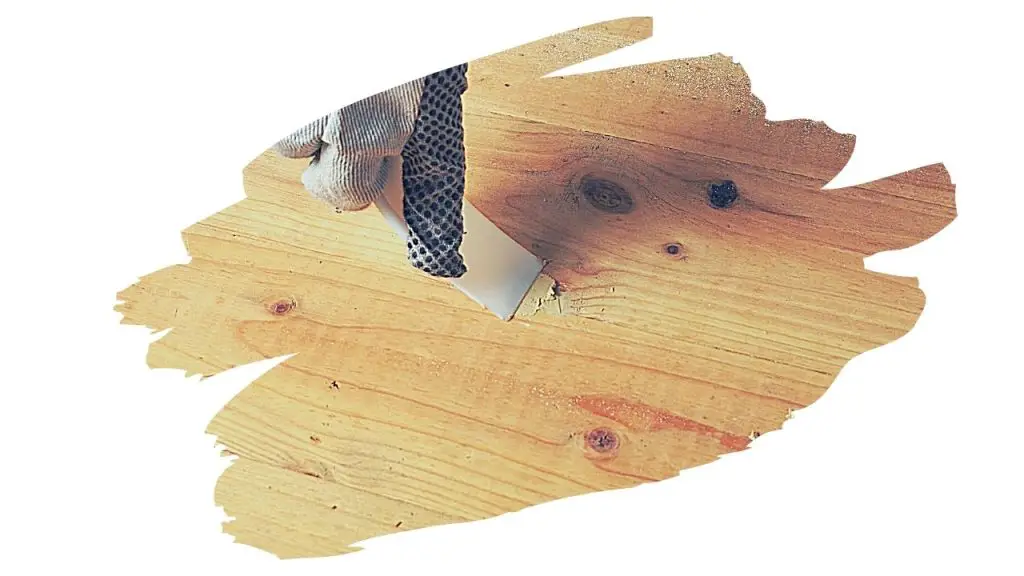So, you’ve just finished creating your hand-made fine dining table. And it looks great! Except, on closer inspection, you are seeing some very visible imperfections across that table surface.
Those cracks and gaps are pretty hard to ignore. So naturally, a half-decent wood filler is your best chance at fixing those problem crevasses.
But, will polyurethane fill in cracks in a wood table?
You can use polyurethane to fill in cracks by blending polyurethane with sawdust (ideally sawdust from the same wooden table you are going to be filling in). You can then use this polyurethane/sawdust mixture to fill in those fine cracks and crevices.
Now, as with everything woodworking, there is always a bit more to consider before you get to work.
So keep reading to discover everything you need to know before you start filling in those grooves…

This post may contain affiliate links to products that we receive a commission for (at no additional cost to you). Learn more here.
First Things First… Can You Put Polyurethane On Wood?
Polyurethane is a type of wood finish that protects wood by covering it in a water resistant coat. It is also incredibly durable, preventing scratches and chips from marring the timber. So, yes, you can freely put this finish on wood.
However, polyurethane can make wood appear a little lifeless. Why? Well, because polyurethane is made from plastic. Or to be more precise, it is made from a urethane polymer material.
So when you use this finish it can leave the table top looking like its just been vacuum-wrapped in a thin sheen of cling film.
So, Can You Use Polyurethane As A Filler?
In theory, yes. Add a couple of drops of polyurethane specifically to the areas that have cracks. And then give it time to cure into a clear hard resin. You can then sand the surface smooth afterward.
In practice, however, all of those poly-filled gaps may stand out in a way that will mar the look of the table.
You see, the crevasses may have been filled in, but the clear-coat nature of poly will mean that they are still very visible to the naked eye.
The contrast is none more stark than when poly is used as a gap-filler on furniture made from dark woods (such as Mahogany or Walnut lumber).
Sawdust and Polyurethane: The Right Combination?
Polyurethane alone doesn’t make for the best looking wood filler. Although it will still get the job done by filling those gaps.
Still, you can make your own homemade wood filler by blending polyurethane with sawdust.
A DIY wood filler in this instance would be made by mixing fine sawdust, (ideally saw dust gathered from the same wood type as your table is made from), and polyurethane together. You can then fill in those table gaps with this mixture instead.
The real trick with using a DIY wood filler is getting the color to match perfectly.
So, check out Scott’s (from Scott Saws on Skates) video below to learn how to get that color blend to match just right:
Also, you may find it difficult to match the fillers color to the tables tone. So before you start filling in those gaps, maybe try testing out the DIY wood filler first. Apply the wood filler mixture onto a piece of leftover wood scrap. That way you can make sure you get the blend just right – without risking messing up your table project.
Can You Fill Knots With Polyurethane?
Using polyurethane filler on cracks and fine gaps is one thing. But using it on deep knots is quite another.
As a rule of thumb, don’t use polyurethane to fill wood knots for two reasons;
- Curing Problems
Polyurethane is too viscous and thick to ever really fully cure into very deep wood knots.
- Rising Bubbles
When you fill in deep knots you need to use a slow curing epoxy knot filler.
Why? Well, because a slow curing filler will allow bubbles of air to escape from the wood knots. These bubbles will naturally rise up through the epoxy, and then pop on the surface.
This bubble-release process takes time (as in days, not hours). So a slow-curing filler, such as UVPoxy from Ecopoxy, is the best option for wood knots.
This particular Ecopoxy product, for example, takes around 2 days to cure (subject to humidity and temperature).
Click here to check out the latest price for Ecopoxy’s UVPOXY over on Amazon.
How Do You Prep Wood For Applying Polyurethane Filler?
You’ve probably heard somewhere that it is incredibly important to clean wood first before you go applying a coat of poly finish.
The last thing you want is for dust, dirt and lint to get caught up in that smooth finish.
However, in the case of applying wood filler, cleaning the wood thoroughly beforehand isn’t as important.
Don’t get me wrong, it is probably good practice to take the time by prepping the wood anyway. Prepping involves wiping the table surface down with a tack cloth, and vacuuming up any excessive saw dust. Also you could consider running a mineral-spirit-dampened rag over the wood too.
Still, all of this prep isn’t required when you are simply filling in cracks. It is only needed if you are applying the finish wholly across the table top.
Final Thoughts
To sum up, polyurethane can be a very easy DIY way of filling in cracks. Especially if you can’t get your hands on epoxy wood filler at a pinch.
So just remember, if you want to use polyurethane to fill in cracks, then:
- Use a polyurethane/sawdust mixture as a filler. The sawdust ingredient is so that the polyurethanes color matches that of the wooden table.
- Avoid using polyurethane filler on any knots in the wood as polyurethane won’t cure properly inside very deep knots.



